The Two Pizza Rule: A Recipe for Productivity
This guide will walk you through the essential elements of using two pizza rule - the productivity method to keep your team productive and engaged.
Try Lark for Free
The two pizza rule is a concept that has gained significant attention in the business world, especially among teams looking to elevate their productivity and collaboration. In this article, we'll delve into the origins of the two pizza rule, its applicability, pros and cons, and provide actionable tips for implementation.
What is the Two Pizza Rule in the Context of Productivity?
The two pizza rule is a guiding principle that suggests that teams should ideally be small enough to be fed by two pizzas. This concept was introduced by Jeff Bezos, the founder of Amazon, with the belief that smaller teams are more agile, innovative, and capable of making faster decisions. In essence, the rule encourages the formation of smaller, more focused teams to enhance productivity and efficiency.
The Origin of the Two Pizza Rule
The two pizza rule was coined by Jeff Bezos during the early days of Amazon. He observed that larger teams often faced communication challenges and slowed down decision-making processes. By introducing the two pizza rule, Bezos aimed to foster a culture of autonomy and accountability within the organization.
Who is the Two Pizza Rule For?
The two pizza rule is suitable for a wide range of businesses and organizations, especially those operating in dynamic and fast-paced environments. It is particularly beneficial for startups, tech companies, and creative teams looking to streamline their operations and foster innovation.
Pros and Cons of the Two Pizza Rule
While the two pizza rule offers numerous advantages, it also has its drawbacks that need to be considered before implementation.
Pros
- Enhanced Collaboration: Smaller teams promote better collaboration and allow members to actively engage in discussions and decision-making processes.
- Improved Productivity: With fewer team members, tasks and projects can be completed more efficiently, leading to enhanced productivity.
- Faster Decision-Making: Smaller teams have a streamlined decision-making process, resulting in quicker responses to challenges and opportunities.
Cons
- Resource Limitations: Smaller teams might face resource constraints and could be overwhelmed with a high volume of work.
- Limited Skill Sets: In some cases, the skill sets within a smaller team might be limited, leading to potential skill gaps in handling complex tasks.
- Sustainable Growth: Scaling a business with small teams may pose challenges in terms of managing an expanding workload.
Use Lark to unleash your team productivity.
How to Get Started with the Two Pizza Rule
Implementing the two pizza rule requires careful planning and consideration of various factors. Here's a comprehensive guide to initiate the adoption of this rule within your organization.
Assess Your Current Team Structure
Evaluate the existing team dynamics and identify areas where smaller, focused teams could bring about notable improvements.
Define Project-Specific Teams
Instead of traditional departmental structures, consider forming project-specific teams that align with the key objectives and deliverables.
Establish Clear Communication Channels
Facilitate open and transparent communication channels to ensure that smaller teams can effectively collaborate and share relevant information.
Embrace Agile Methodologies
Incorporate agile methodologies to empower smaller teams with the flexibility to adapt to changing project requirements and deliverables.
Foster Autonomy and Accountability
Encourage team members to take ownership of their roles and responsibilities, fostering a sense of accountability within smaller teams.
Actionable Tips for the Two Pizza Rule
To effectively implement the two pizza rule, consider the following actionable tips:
- Empowerment: Empower team members with the autonomy to make decisions within their areas of responsibility.
- Regular Reviews: Conduct regular reviews to measure the effectiveness of smaller teams and make adjustments as necessary.
- Cross-Functional Collaboration: Encourage collaboration between different smaller teams to leverage diverse skill sets and perspectives.
Learn more about Lark x Productivity
Do's and Dont's
| Do's | Dont's |
|---|---|
| Encourage open communication | Underestimate the resource requirements |
| Foster a culture of accountability | Overload small teams with excessive tasks |
| Empower team members to make decisions | Neglect regular performance evaluations |
Use Lark to unleash your team productivity.
Conclusion
In conclusion, the two pizza rule offers a compelling framework for enhancing productivity and collaboration within organizations. By fostering smaller, more agile teams, businesses can navigate challenges effectively and capitalize on emerging opportunities. However, it is essential to carefully assess the readiness of the organization and its teams before transitioning to this approach.
FAQs
What are the Key Benefits of the Two Pizza Rule?
The two pizza rule promotes enhanced collaboration, faster decision-making, and improved team productivity, leading to more efficient task execution and project delivery.
How Can We Overcome Resource Limitations with Small Teams?
To address resource limitations, it is crucial to conduct thorough resource planning, prioritize tasks, and consider leveraging external support if necessary.
Is the Two Pizza Rule Applicable to Non-Tech Businesses?
While the concept was popularized in tech companies, the two pizza rule can be adapted and applied effectively in various industries and businesses that prioritize agility and innovation.
What Role Does Team Empowerment Play in the Two Pizza Rule?
Team empowerment is a fundamental aspect of the two pizza rule, as it fosters autonomy, accountability, and proactive decision-making within smaller teams.
What Challenges Could Arise When Implementing the Two Pizza Rule?
Common challenges include potential skill gaps within smaller teams, resource constraints, and the need to ensure sustainable scalability as the organization grows.
By embracing the essence of the two pizza rule and navigating its complexities, organizations can pave the way for a more collaborative, agile, and productive work environment.
